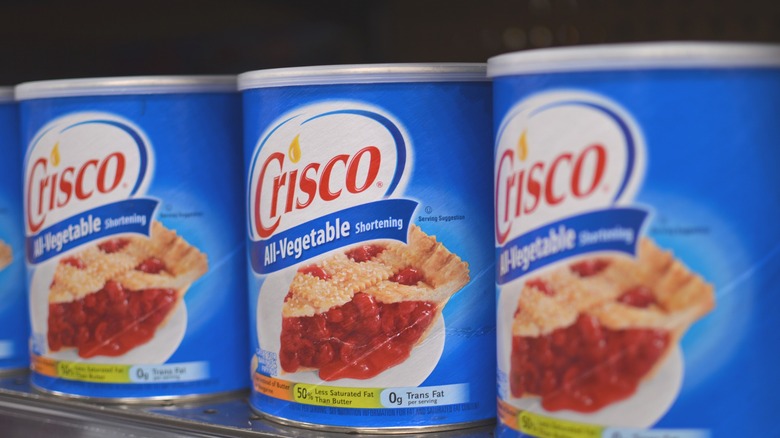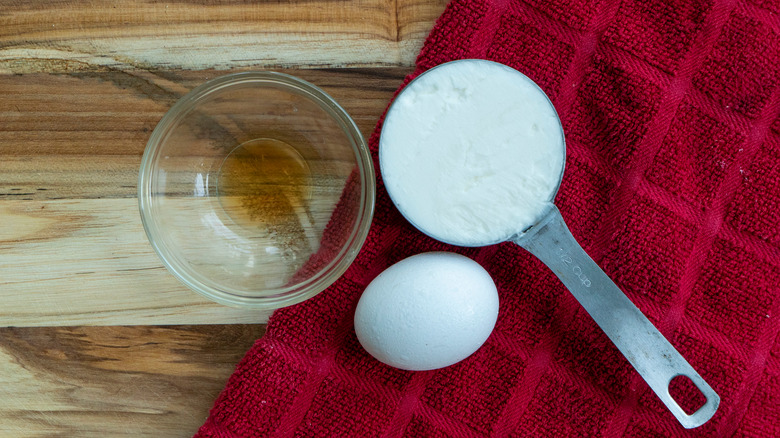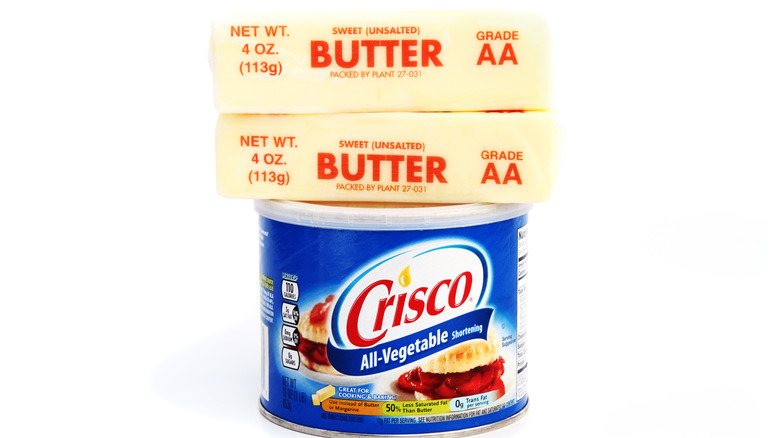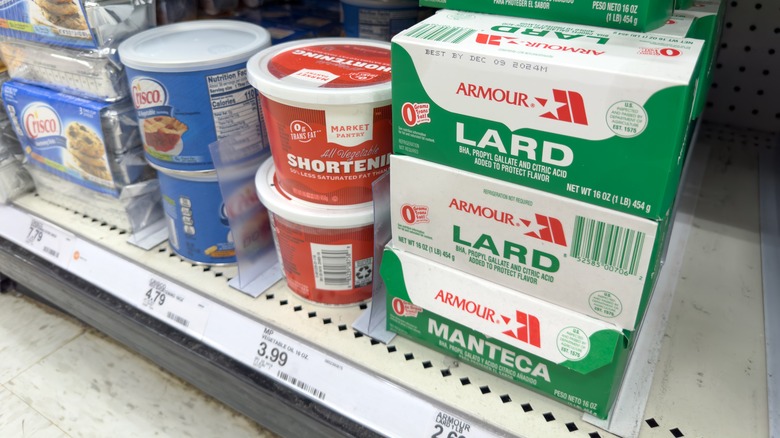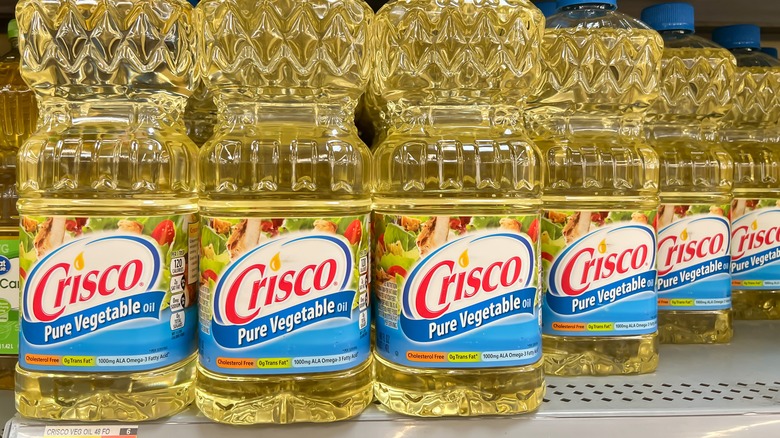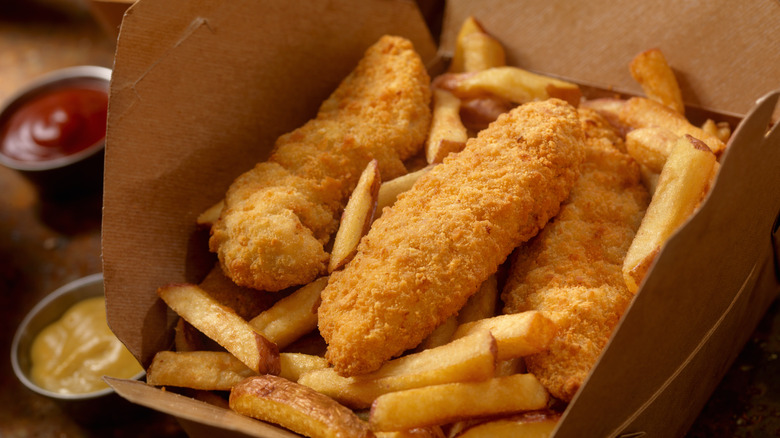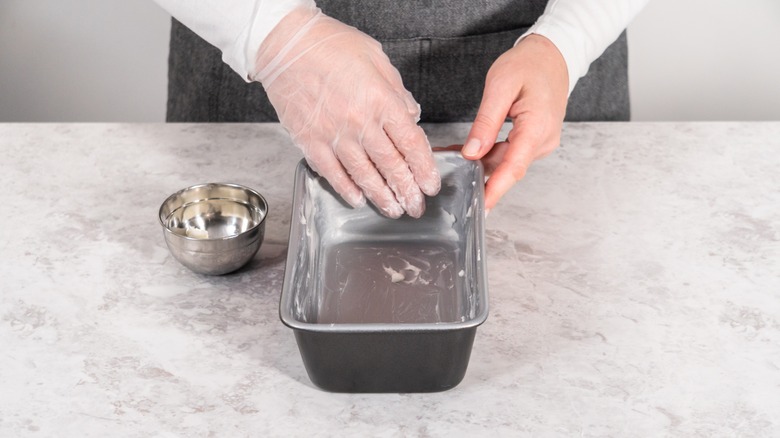A Guide To Crisco And How You Can Use It
Crisco has been found in America's kitchens for more than a century. Debuting in June 1911, Crisco is now ubiquitous in American culture — so much so that, over the decades, its name has been attached to everything from home cooking to LGBT disco clubs. Growing up, the familiar blue can was ever-present in our kitchen pantries and remains so as an adult.
Despite pushback against Crisco in recent years, it remains a household staple in the U.S. In 2020, more than 90 million Americans used it at least once. Even with price increases due to the ingredients rising in cost, sales remain strong. Per an earnings calls from parent company B&G Goods Inc., while total sales in the second quarter of 2023 dropped 7% year-over-year, this came on the heels of a 23% increase for the same period the previous year.
The value of the brand was proven in 2020 when B&G Foods Inc. acquired Crisco from J.M. Smucker Co. for $550 million. But what exactly is this substance that a company was willing to pay more than half a billion dollars for? And what is it best used for? We researched the history of Crisco, what's inside it, how it compares to similar baking products, and more to put together the ultimate guide to Crisco.
What is Crisco? A very quick history
Let's start with the obvious question. Crisco is a type of shortening, which can refer to any fat used for cooking and baking that remains solid at room temperature. More specially, Crisco is a vegetable shortening made from hydrogenated vegetable oil (more on this in a moment). Its name is a portmanteau of "crystallized cottonseed oil," which was the original oil used to make it.
Crisco claims to be the first shortening made solely from vegetable oil; previous attempts at shortening blended regular cottonseed oil with other products such as beef fat (via The Conversation). Furthermore, in touting itself as an alternative to lard and butter, Crisco distanced itself from the cottonseed origins — partly because the oil was developing a poor reputation due to other companies' deceitful practices and partly because Americans tended to think of clothing and linens when you mentioned cotton to them.
When you add in an aggressive marketing campaign that included emphasizing brand purity and publishing massive cookbooks with Crisco as a constant ingredient, the brand took off. Within five years of its 1911 introduction, annual sales had reportedly surpassed 60 million cans of Crisco. The brand continued to soar from there.
In the 21st century, the brand has changed hands multiple times. Before the B&G Foods purchase, Proctor and Gamble divested Crisco in 2002, merging it and Jif peanut butter with J.M. Smucker Co. in an all-stock deal worth an estimated $1 billion.
How is Crisco made?
We already mentioned the Crisco shortening formula involves hydrogenated oil. But what is this process, exactly? According to Hydrogenation, it's when hydrogen gas is mixed into liquid oil using a nickel catalyst. The resulting reaction changes the oil to a solid or semi-solid substance while making it more shelf-stable. You can have fully hydrogenated oil, which is a fully saturated fat, or partially hydrogenated oil. (Incidentally, when Proctor and Gamble filed its U.S. patents for hydrogenation, it was originally planning to use the process to make soap.)
The original Crisco formula used partially hydrogenated cottonseed oil, and it chugged along largely uninterrupted for most of the 20th century. Things eventually began to turn, though. Partial hydrogenation produces trans fats, and as noted by NPR, the 1990s saw increasing scientific evidence that trans fats are very harmful to health. The ball kept gaining speed until, in 2015, the FDA ordered all U.S. companies to transition away from using partially hydrogenated oils in food, with the deadline eventually set for January 1, 2021.
Crisco had already acted, though. In 2007, the brand overhauled the recipe to make it trans-fat-free. Crisco shortening now uses soybean oil as a base with regular and fully hydrogenated palm oils to make it solid. The ingredient list also includes mono and diglycerides along with TBHQ and citric acid to help prevent oxidation.
What does Crisco taste like?
Regardless of what's in Crisco, it's never been anything that most people are going to want to just scoop out and eat plain. The flavor has best been described as neutral — in other words, it doesn't taste like much of anything. This makes sense considering that it's made from vegetable oil, which is considered a neutral oil whether it comes from cotton seeds, soybeans, corn, or any other nut or seed. A neutral taste might not be a big deal to you, especially with recipes that have a lot of other flavor sources. However, if you're looking for an additional kick, Crisco won't provide it — unless it's an off-flavor from your shortening going bad.
Of course, this wasn't always the case for the original cottonseed oil base. Throughout much of history, cottonseed oil was dark, pungent, and foul-tasting, meaning little effort was made to produce it. Finally, in 1899, chemist David Wesson developed a method to clean up and refine cottonseed oil, eventually paving the way for Crisco. We can only imagine what oil would have been used or what the product name would have been without Mr. Wesson.
Nutritional information about Crisco
So what are you getting for nutrients when you add Crisco to a recipe? An official serving size is 1 tablespoon, which contains 12 grams of total fat and 3.5 grams of saturated fat. This is 15 and 16%, respectively, of the recommended daily value in a 2,000-calorie diet. Of the unsaturated fats, 6 grams are polyunsaturated and 2.5 grams are monounsaturated, which both have been associated with positive effects on cholesterol levels and inflammation, per Verywell Health.
Speaking of which, Crisco is cholesterol-free, and it's also officially gluten-free and kosher pareve — i.e. it contains no meat or dairy products, making Crisco safe for Jewish dietary laws, vegetarians, and vegans alike. Each serving of shorting also gives you 44% of the recommended daily intake for alpha-linolenic acid (ALA), an omega-3 fatty acid that is believed to reduce the risk of cardiovascular disease, heart disease, and blood clotting, as noted by WebMD.
What's also notable are some of the things not in Crisco. It contains no significant amounts of protein, dietary fiber, carbohydrates, salt, or vitamins and minerals. This isn't a surprise knowing Crisco originates from liquid fat — and we doubt most people were looking to Crisco as a source of protein or vitamin C anyway. But if you're counting macros for dietary purposes, this info gives you the full picture.
Crisco vs butter
Now it's time to put Crisco head-to-head against the products it was marketed as a replacement for, starting with butter. By the official definition, both Crisco and butter (along with margarine and lard) are types of shortening. Crisco can even be used measure for measure to replace butter in recipes and vice versa.
However, you won't get quite the same result. Vegetable shortening traps more air than butter and has no water content. Major butter brands, on the other hand, are typically between 15 and 18% moisture. Shortening also melts at a temperature of 111 to 116 degrees Fahrenheit versus 100 degrees Fahrenheit for butter.
Because of these properties, using Crisco in baked goods will produce a little more rise and a softer, lighter texture. Shortening also holds its shape more when baking. As for the contents, Crisco has 1 gram more of total fat, but 50% less saturated fat than butter. On the other hand, butter gives food more flavor, and it has some vitamins like A and D that Crisco doesn't.
All in all, barring specific dietary issues and choices — such as milk allergies or being a vegan — we've found that one product isn't necessarily more nutritious than the other. It ultimately comes down to what you're looking for from certain recipes.
Crisco vs lard
So how does Crisco compare to lard? The obvious difference is that, like butter, lard is animal-based — specifically, it's rendered pork fat. So lard is off-limits not just to vegans but vegetarians as well.
There are some similarities between vegetable shortening and lard, though. The consistency and texture are very much alike, and they also resemble each other in terms of melting temperatures and total fat. If you're using leaf lard — which is lard specifically from the kidney area — then it's pretty much interchangeable with Crisco in terms of basic function. (If you just have regular lard, you should primarily use it for frying.)
That's where the comparisons end. Among the many differences, lard imparts a subtle but distinct pork taste to food versus the lack of flavor in Crisco. If you like a meaty flavor, that's great, but it could be surprising or off-putting to some — especially in baked goods. Lard also has much more saturated fat with 5 grams per tablespoon, though it does offer some Vitamin D. And if you're on a budget, shortening is generally less expensive and can be stored for longer.
Where to buy Crisco
If you're looking for a place to buy Crisco, you don't have to search for long. It's available at pretty much every grocery store as well as department stores with a food section. From Walmart to Amazon, Aldi to Price Chopper, a tub of vegetable-based shortening isn't far away.
Most retailers carry 1- to 3-pound tubs of Crisco. The company switched to glass jars during World War II, but has since returned to the iconic blue can packaging. The 1-pound tub is roughly equivalent to 2-1/3 cups — this is slightly more than the 2 cups per pound of butter and margarine because shortening is less dense. Do you need a lot of Crisco for a professional eatery or shared household? Some wholesale stores such as BJ's carry a massive 6-pound Crisco tub. That's a lot of hydrogenated oil!
Varieties of Crisco
Just like Cherry Coke, Honey Nut Cheerios, and other off-shoots of iconic brands, there are multiple types of Crisco. Do you want the rise, texture, and lower saturated fat of shortening but with the added taste that butter provides? Since 1981, Crisco has offered Butter Flavor All-Vegetable Shortening to give you the best of both worlds. (Sadly, it's not available in the 6-pound industrial tub.) Since the early '90s, both original and butter-flavored Crisco have been available for purchase in convenient baking sticks to use like butter or margarine. You can purchase a single 1-cup stick (proportionate to two sticks of butter) or a three-pack.
The Crisco name has been attached to other kitchen products, too. In a great irony, you'll find half a dozen Crisco-branded cooking oils, including Pure Vegetable Oil, Pure Canola Oil, Pure Corn Oil, and Frying Oil Blend. There are also five different Crisco cooking sprays ranging from the original no-stick spray to Professional Grill Master grilling spray. Finally, for those committed to buying organic, there are refined and unrefined Crisco coconut oils that are USDA-certified organic and Non-GMO Project verified for a natural food approach.
How to store Crisco
We've already discussed the shelf stability that the Crisco-making process offers. But how do you store it for the best results? The company recommends storing its shortening, as well as its other products, on a pantry shelf or in a cupboard. Make sure the area is dry and isn't exposed to direct sunlight or strong smells. You should also have a buffer against ovens, dishwashers, and other appliances that produce a lot of heat.
What about refrigerating Crisco? There's nothing inherently wrong with this method, and it may even be preferable in warmer areas. However, you'll need to let the Crisco return to room temperature before using it. When shortening is cold, the oils thicken, making it firm and thus harder to scoop, cut, or mix just like butter does. Refrigerated shortening will also have a cloudy appearance.
If stored properly, Crisco's all-vegetable shortening will last two years unopened and one year opened. Interestingly, this is much longer than the USDA-recommended times of eight months for unopened shortening and three months for opened shortening. The lifespan is the same for Crisco oils, but baking sticks "only" have an opened shelf life of six months. Crisco cooking sprays should last two years regardless of whether you've opened them or not.
Baking with Crisco
So how exactly can you use Crisco? The time-tested way, of course, is baking. Despite it being slightly lighter than butter and margarine, it's widely accepted that you can substitute Crisco one-for-one. The company advises using shortening whenever you want something to be moist, soft, and fluffy, such as when making cookies and cakes. So if you want to make a cake that is rich yet light, Crisco is the right call. It is also known for producing pie crusts that are light and flaky — and dairy-free to boot. We've also used it to make sticky buns that are irresistible.
Shortening is commonly used in buttercream frosting as well. Adding powdered sugar and the extract of your choice will create a light, fluffy, and tasty frosting that's perfect for cakes and cookies.
And in a pinch, if you've run out of cooking oil, you can melt Crisco and cool it slightly. Doing this all the time isn't endorsed, though, as the heavier texture of oil serves a purpose in certain dishes.
When measuring Crisco, the company suggests using the water displacement method for the most accuracy. For example, if you need 1/4 cup of shortening, put 3/4 cup of water in a 1-cup measure, then top it off with shortening. The Crisco is so light that it will float on the water, explains the University of Illinois Urbana-Champaign. Measuring Crisco shortening sticks is even easier as the measurement markings are on the wrapper.
Frying with Crisco
When it comes to cooking with Crisco, you're not limited to desserts and doughs. Melted shortening can be mixed with other cooking oils or used by itself to fry foods. It's often used in Southern cooking as a substitute for lard, and Crisco will make things like chicken tenders, fries, and potato chips nice and crispy. The neutral taste can be a blessing, allowing your seasonings to have the spotlight without an oil flavor dulling them.
Once you're finished using it, the remaining Crisco can be stored for reuse. Make sure to filter or strain it while it's still liquid to remove large chunks, then put it into a heat-safe container with an airtight lid and store it like you would regular Crisco. Be aware that, unlike raw shortening, reused Crisco can spoil in as little as a few weeks — watch out for discoloration and foul odors. Note that Crisco used for frying will retain some flavor from whatever you fried.
It should also be noted that traditional cooking oil will likely be more affordable, especially for larger items. At our local Shaw's supermarket, a 48-ounce tub of Crisco shortening is $9.99 as of this writing. Meanwhile, a 48-fluid-ounce bottle of Crisco Pure Canola Oil is only $6.99. So keep this in mind when deciding which to use.
Using Crisco on cookware
Here's a confession: For many years, we thought the only thing Crisco was for was to grease baking pans. While we've since discovered other great ways to utilize it in the kitchen, the blue can is still what we reach for when it's time to prepare a pan for a cake or quick bread. Just spoon some onto the pan and rub it around until fully coated; you can put your hand in a disposable glove or sandwich bag if you don't want to have greasy fingers. We've found dusting some flour onto the Crisco-greased pan is the perfect combination to prevent sticking.
Crisco can also be used to season and re-season cast iron skillets. Apply Crisco to a 200-degree Fahrenheit rust-free skillet, let it melt, then use a paper towel to wipe it away. Bake the pan upside down at 300 degrees Fahrenheit for 15 minutes, lightly wipe it once more, then bake it at 400 degrees Fahrenheit for two hours before cooling. The polymerization reaction makes the surface easily release food, prevents rusting, and gives cast iron cookware its familiar black color. You can repeat the process up to four times for an even deeper Crisco sheen.
Other uses for Crisco
Like all great products, people have found uses for Crisco beyond what the makers intended. Let's look at a few ways Crisco helps you outside the kitchen.
For starters, you can use Crisco if you don't have regular facial moisturizer handy. Since it's made with palm oil, it can seal in moisture for fast rehydration. It's also a low allergy risk and is particularly efficient on eczema, according to Dr. Melanie Palm, board-certified dermatologist, per Today.
The "moisture barrier" effect of Crisco works in reverse, too. Pharmacologist Joe Graedon says Crisco is an effective diaper rash remedy, sealing the area so it can heal (via The People's Pharmacy). Apply the Crisco as-is or use cornstarch to make a cream.
In fact, you can use Crisco from head to toe. Actress Viola Davis is among those who apply Crisco to their feet (via People). The moisturizing properties soften bunions and calluses and reduce cracking. It also lowers friction when you're wearing heels and other footwear without socks.
And of course, there's always an old-fashioned pole greasing. When the Philadelphia Eagles were about to play the Minnesota Vikings in the 2018 NFC Championship game, local police spent hours coating the street poles with Crisco to prevent fans from climbing them if the Eagles won. Despite the efforts of the "Crisco Cops," fans were so stoked after the 38-7 victory that they tried to anyway.
